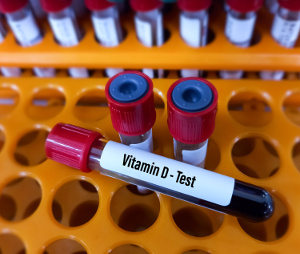Taking vitamin D can lower your melanoma risk by 50 percent
 Considerably fewer cases of melanoma are found among people who take vitamin D supplements regularly compared with those who don’t. This was demonstrated in a new Finnish study that is published in Melanoma Research. The study supports earlier research that shows that lack of vitamin D doubles your risk of dying of melanoma.
Considerably fewer cases of melanoma are found among people who take vitamin D supplements regularly compared with those who don’t. This was demonstrated in a new Finnish study that is published in Melanoma Research. The study supports earlier research that shows that lack of vitamin D doubles your risk of dying of melanoma.
Most of the cells in our body have vitamin D receptors that regulate a variety of genes and metabolic processes. Also, scientists have observed a relation between vitamin D deficiency and skin cancer, but these studies have primarily been related to vitamin D in the form of calcidiol or 25-hydroxyvitamin D3, the kind of vitamin D that is measured in the blood. There are also a few studies that do not show a direct link. This may be because they have failed to look at the vitamin D synthesis in the skin and how effectively the body is able to convert vitamin D into the active form called calcitriol (1,25 dihydroxyvitamin D3)
In the new study that was conducted as part of the North Savo Skin Cancer Program, the scientists chose a different approach. The study included a total of 498 patients from the department of dermatology at Kuopio University Hospital in Finland. Dermatologists from the University of Eastern Finland analyzed the patients’ background and medical records. Their skin was also examined. The patients were divided into three different risk categories depending on their risk of developing skin cancer (low, moderate, or high risk). Based on their intake of vitamin D supplements, they were divided into non-users, occasional users, and regular users.
In half the patients, blood levels of calcidiol were measured to see how this correlated with their self-reported use of vitamin D supplements. The scientists found substantially fewer cases of melanoma among regular users of vitamin D supplements compared with non-uses. It turned out that regular users of vitamin D only had half the risk of developing melanoma compared with non-users. The study shows that occasional vitamin D supplementation can also lower the risk of melanoma, but the effect is not statistically significant.
The scientists from University of Eastern Finland and Kuopio University Hospital mention other studies that have shown that having sufficient vitamin D can make melanoma less aggressive.
They also report that the melanoma rate in North Savo in the Eastern part of Finland is comparatively high. It is therefore very important for people in this region to make sure to get enough vitamin D. The same is the case with other populations that are prone to deficiency
The researchers say that the jury is still out on finding the optimal vitamin D dose in supplements. So far, they recommend people to follow the official recommendations.
- Melanoma is the most dangerous type of skin cancer
- Sunburns in the childhood and youth are thought to play a greater role than sunburns later in life
- The melanoma rate has grown rapidly in the past 50 years
- It is healthy to be out in the sun and get a tan – just avoid burns
Being vitamin D-deficient doubles the risk of dying of melanoma
According to a Spanish study, lack of vitamin D can double your risk of dying of melanoma. The study was presented at the European Academy of Dermatology and Venereology Congress.
In studies of mice, scientists from the University of Leeds in England showed that vitamin D affects melanoma cells by way of different genes and signaling pathways, and that makes these cells less aggressive. The study is published in Cancer Research.
Vitamin D supplementation
At our latitude, the summer sun is the main source of vitamin D. In the winter period, however, we are challenged, and the problem is made even worse by factors such as spending too much time indoors, ageing, being dark-skinned, being overweight, and having type 2 diabetes. Also, sun awareness campaigns have contributed to the problem with vitamin D deficiency. The health authorities recommend for everyone to take a vitamin D supplement during the winter period. The same goes for people who do not get enough sun during the summer or belong to one of the vulnerable groups where there is an increased risk of being deficient. The official recommendations suggest getting between 5-20 micrograms daily. Some people may need to take more in order to optimize their blood levels of the nutrient. The European Food Safety Authority (EFSA) has established a safe upper intake level of 100 micrograms per day.
- Vitamin D works by way of different mechanisms to protect against different kinds of cancer, including melanoma
- Patients with melanoma should have their vitamin D status measured
- Vitamin D-deficient melanoma patients should take a vitamin D supplement to optimize their blood levels of the nutrient
- This is very likely to improve the outcome of standard melanoma therapy
References:
University of Eastern Finland. Fewer cases of melanoma among people taking vitamin D supplements. ScienceDaily. 2023
Regular use of vitamin D supplement is associated with fewer melanoma cases compared to non-use: a cross-sectional study in 498 adult subjects at risk of skin cancers. Melanoma Research, 2022
European Academy of Dermatology and Venereology. Vitamin D deficiency in melanoma patients associated with worse overall survival, new study finds. MedicalExpress 2022
Sathya Muralidhar et al. Vitamin D-VDR signaling inhibits Wnt/beta-catenin-mediated melanoma progression and promotes anti-tumor immunity. Cancer Research 2019
Modermærkekræft (malignt melanom) - Patienthåndbogen på sundhed.dk
Search for more information...
- Created on .








